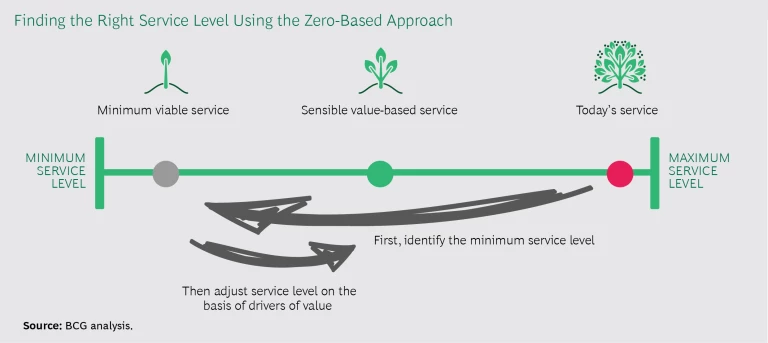A major hotel chain decided to cut its ballooning HR costs by 20% in six months—an ambitious target, but one the project team believed it could easily reach using agile work methods and a minimum viable project approach. The plan: to digitalize core processes and outsource the transactional ones to an offshore shared-services center. But in short order, the plan fell apart. The company’s IT infrastructure was a morass of newer and legacy applications that made the goal of quickly digitalizing existing processes out of the question. And IT systems, it turned out, could not be operated from the offshore location. What had looked promising on the whiteboard turned out to be impossible.
It’s a story that plays out across industry sectors and change efforts, particularly in this age of digital transformation. Companies embark on a project intending to optimize every existing process. Leaders expect that digitalizing processes will be a slam dunk for cost reduction. Sure, digitalization can yield tremendous efficiencies—but not without some vital preliminary actions. Companies must first figure out which services are truly essential for running their core business. They must then streamline the essential services and get rid of the rest. Then—and only then—can they digitalize.
The most promising approach for drilling down to the process essentials is zero-based organization (ZBO). Done right, ZBO helps streamline functions and produce efficiencies, freeing up resources for where they will count most. For organizations undergoing digitalization or adopting game-changing technologies such as machine learning or robotics, ZBO can help unleash the full value of their investment.
Less Really Is More
Few functional leaders have a clear map of the services that drive their core business. And even fewer have protocols in place for reevaluating services and activities and switching off those that are no longer needed. As a result, companies end up with duplicative or unnecessary work that can erode value, sometimes substantially. And unlike in manufacturing, where waste is physical and thus more visible, waste in “white collar” administrative and functional processes is harder to detect: the report with all the KPIs the old CEO preferred, a preliminary approval that’s no longer required, or HR’s involvement in new-hire interviews. Such waste has historically fallen outside the scope of lean and other waste-minimizing techniques.
ZBO is designed to root out such waste by simply eliminating work. It forces companies to rethink the activities they carry out from the ground up and define them with two key dimensions in mind—urgency and value. As much a mindset as it is an actual approach, ZBO represents the desire to reduce work to the essentials: what is needed to run the business and what is required by regulation. It is about abiding by the maxim that “less is more.”
Like zero-based budgeting , ZBO involves working from a clean slate to identify the way business will be done. ZBO zeroes in on the functional and administrative processes and activities of the business. Businesses can then clearly distinguish between baseline essentials and discretionary activity and know the actual costs and value of the two types of work. They also spare themselves the hassle and complexity of outsourcing or moving soon-to-be irrelevant work to a shared-services center. The result: leaner, simpler business functions that require anywhere from 30% to 70% fewer resources.
ZBO results in leaner, simpler business functions that require anywhere from 30% to 70% fewer resources.
Four Steps to ZBO
Any zero-based organization effort should begin by taking four foundational steps: document services and the experiences of their providers and customers, inventory and classify existing processes and their component activities, define and reevaluate service levels, and optimize. These steps are important for many reasons, not least among them that they provide an objective, factual basis for decision making. Reducing or eliminating activities will mean the loss of power or even employment for some; a fact-based approach helps keep emotion out of the decisions.
Document the Services
Teams must first understand who is doing what for whom (and how well) in each of the functional or administrative areas in question. How do the recipients—the customers—rate the services in key dimensions, such as speed, quality, supporting systems and tools, and quality of process documentation? Understanding the service providers’ views is equally important. What do the people who work in the area consider to be obstacles to doing a good job? What makes their work overly complicated?
Inventory and Classify Existing Activities
In general, the activities comprising a process can be classified as mandatory, core, or strategic. Using the data gathered in the first step, teams should identify the processes and activities that are absolutely necessary to run the business and comply with laws and regulations. For an HR department, for instance, these would include such things as managing employee data or procuring and maintaining safety gear for plant workers; in a finance department, they might include producing an annual report or filing tax documents.
All activities beyond those that are legally mandated are discretionary and can be classified as either core or strategic. Core activities are equivalent to keeping the lights on: they don’t directly improve the business but are vital to its customers. Examples include accounts payable and receivable, shipping and receiving, and payroll. Strategic activities are those that are crucial for customers as well as those that are consequential to performance. Such activities include business performance reporting, market research, and strategic workforce planning. The classification of some activities will vary by company or industry.
Define and Reevaluate Service Levels
The next step is to define the appropriate service level for each activity. To begin, identify the minimum service level required to keep the company afloat based on the previous two steps. Then, working with each of the internal customers, agree to a level of service, one that is based on what is most important to the customer (that is, the main value driver) and what future capability is needed. Know the cost for each service adjustment so you can provide a cost-benefit profile to help customers make an informed decision about their needs. (See the exhibit.)
Optimize
Once the classification is completed, leaders can craft the optimization strategy. It’s important that the company take action in the following order.
Stop the activities deemed no longer useful. By “stop,” we mean a complete halt, not an incremental reduction or phaseout over time. A bold move such as this can be seen as harsh, so it’s best that companies don’t leave the decision to the service provider or internal customer. Transparency is important; it behooves company leaders to explain how the reduction will enable the organization to reallocate resources to the areas of greatest need.
Mandatory activities should be standardized as much as possible. If appropriate, they should be automated or outsourced. Companies then need to reduce other core and strategic activities to sensible minimum service levels. To define the right level for these activities, service providers and customers should explore various scenarios and their associated tradeoffs. For example, a company may be able to cut by half the time it takes to fill a position by using a standard offer letter and set pay grades—but the tradeoff for this increased efficiency might be more difficulty recruiting top talent in a hotly competitive field.
Redesign the service operating model. Having reached agreement on appropriate service levels, providers and customers should work together to redesign the service operating model. If, for example, the recruitment and job analysis services offered by a company’s shared-services HR unit go largely unused, the redesign might call for returning those functions to local units and keeping centralized activities to a minimum (such as benefits and compensation administration). If, however, regional units have insufficient expertise, achieving a sensible minimum service level might instead call for simply reducing the menu of shared services to only those that require specialized knowledge or expertise.
If appropriate, core services should be automated; payroll, for example, is a natural candidate for this. Core services should also be harmonized (that is, roughly standardized) to the extent possible, with a handful of variations to address the unique needs of certain units or departments.
Strategic services should be optimized according to their most important value, whether it’s speed, flexibility, security, cost efficiency, or some other value. In business performance reporting, for instance, speed might be more important than flexibility, whereas flexibility might be the top priority in strategic workforce planning. All value characteristics of the process should be prioritized on the basis of what the internal customer and provider have agreed are most important.
Once the operating model has been determined, the processes and activities can be optimized using classic lean and organizational levers such as streamlining process steps, clarifying roles and responsibilities, standardizing inputs and outputs, and reducing process variance.
It’s worth noting that while ZBO positions companies to achieve substantial benefits, sustaining those benefits can be a challenge. Organizations naturally tend toward complexity over time. A less-is-more mindset is crucial, something companies can promote in a variety of ways. BCG’s approach to sustainable behavioral change is rooted in our Smart Simplicity concept. (See Mastering Complexity Through Simplification: Four Steps to Creating Competitive Advantage , BCG Focus, February 2017.)
Now, Digitalize
Digitalization, of course, is one way to fight complexity, and ZBO positions companies to reap its full benefits. Digitalization enables companies to lock in workflow, thus preventing process creep. It also makes it easier for them to automate activities or their components, such as screening résumés or gathering expense data, which further enhances efficiencies and process effectiveness. In fact, we have found that ZBO usually strengthens the business case for digitalizing processes—and increases the proportion of projects completed on time and on budget—largely because the complexities that cause projects to fail have already been removed.
ZBO’s usefulness goes beyond digital transformation. Any transformation effort—from a reorganization to a cost-reduction program—can benefit from ZBO. Working from a clean slate enables the company to improve efficiency and effectiveness simultaneously and to achieve a significant, sustainable reduction of work. The funds saved by ZBO can be reallocated to new value-creating priorities. The ZBO process offers an added benefit: it takes the subjectivity out of an often fraught and painful process, providing a factual basis that also gives the internal customer a say in what matters most. Finally, as an approach, it emphasizes smart simplicity over unnecessary complexity—a mindset that’s crucial to business success in the digital era.











